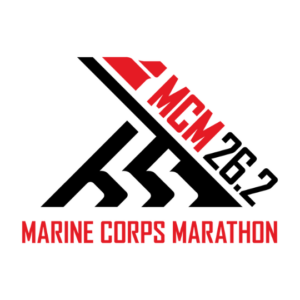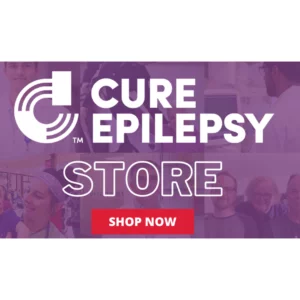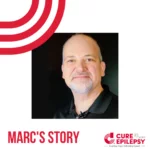Greetings Epilepsy Community,
Summer is here and brings many things to appreciate and enjoy. The weather is warmer, students are completing their school year, graduation ceremonies are taking place, and many CURE Epilepsy Champions hold their events. These Champions are working on events across the United States, rallying their professional networks, friends, family members, and local businesses to help increase epilepsy awareness and raise money for critical epilepsy research. In honor of CURE Epilepsy’s 25th anniversary, we have created the 2023 Champion Challenge, where we are challenging our existing and new Champions to raise a total of $425,000 this year. We are currently at just over $270,000 (well over halfway to our goal)!
I am honored to lead an organization that has so many dedicated community members who are focused on making our goal of a world without epilepsy a reality. We’ve already seen some creative CURE Epilepsy Champion events this year including a 40-mile bike tour, partnering with a local Massachusetts brewery for a month, the second annual Mansfield Walk to CURE Epilepsy (focused on SUDEP awareness), EpiPalooza (a multi-concert performance focused on epilepsy awareness), and the 10th annual 5K Strides for Epilepsy in Maryland (the longest running CURE Epilepsy Champion event)! Coming up this summer we still have plenty of Champion events including the annual Ella’s Race in Illinois, an EpiPalooza concert in North Carolina, and more. If you are interested in hosting a Champion event of your own, you can learn more about how to do so here.
With a commitment to inspire hope and deliver impact.


In this CURE Epilepsy Update, please find information on:
Watch the Recording of Our Webinar: Mental Health and Childhood Epilepsy

Watch the recording or access the transcript for our latest webinar, Mental Health and Childhood Epilepsy. Epilepsy is not a mental health disorder, but epilepsy or epilepsy medications can impact an individual’s mental health. It is important for medical professionals and caregivers to address these concerns quickly. This webinar with Dr. Clemente Vega covers the prevalence of mental health conditions in children with epilepsy, risk factors, resources, and more.
Watch
Epilepsy Awareness Night at Chicago White Sox Game

Join the CURE Epilepsy community for a very special night at the ballpark: Epilepsy Awareness Night with the Chicago White Sox on Saturday, September 2! Come celebrate CURE Epilepsy’s 25th Anniversary with a specially discounted ticket offer, plus, $5 of each ticket purchased for our selected sections will go towards epilepsy research. See the White Sox in a matchup against the Detroit Tigers, sit with other community members, and raise money for epilepsy!
Tickets
New Epilepsy Surgery Resource

Surgery may help cure or significantly reduce the incidence of seizures. To help individuals learn about surgical options and what epilepsies they work for best, CURE Epilepsy has created the Epilepsy Surgery section of our Understanding Epilepsy resource.
Explore Resource
CURE Epilepsy CARES Comes to Seattle

CURE Epilepsy CARES (Conversations About Research in Epilepsy & Seizures) is a free, educational event for patients, families, medical professionals, researchers, and all those touched by or interested in learning more about epilepsy. Join us in Seattle on Saturday, June 10 as clinicians answer your questions about cutting-edge research and epilepsy treatments.
Register
Join Team CURE Epilepsy for the Marine Corps Marathon (MCM)

Join us on October 29 in Washington DC for the 2023 Marine Corps Marathon (MCM). CURE Epilepsy is proud to be a new partner of this annual marathon. You can join fellow Team CURE Epilepsy runners in our nation’s capital as we raise critical funds and awareness in our efforts to find a cure for epilepsy, by promoting and funding patient-focused research.
Register
CURE Epilepsy Discovery: Strides Made in the Understanding of Acquired Epilepsies by CURE Epilepsy Grantees

An acquired epilepsy can occur as a result of brain infection, tumor, or injury leading to spontaneous seizures. CURE Epilepsy grantees, Dr. Annamaria Vezzani and Dr. Teresa Ravizza, study neuroinflammation and the underlying mechanisms that may contribute to epileptogenesis. Their work is instrumental not only to understanding why and how the brain generates and sustains seizures, but also to discovering biomarkers that could predict if someone will have seizures. The ultimate hope is that the work of Drs. Vezzani and Ravizza will lead to the ability to prevent or cure acquired epilepsies.
Explore Discovery
What’s New from the Seizing Life® Podcast
A Daughter’s Diagnosis Inspires Concerts for Epilepsy

Matt Perrone shares his epilepsy onset and treatment journey, the impacts of seizures and medication on his mental health, and how his daughter’s diagnosis at the age of four spurred him to create EpiPalooza, a multi-band concert aimed at raising awareness and funds for epilepsy research.
Watch or Listen
Epilepsy Researcher Compounds Lab Work with Fundraising

Dr. Patrice Jackson-Ayotunde, an organic chemist and Associate Professor of Pharmaceutical Sciences at the University of Maryland Eastern Shore (UMES), explains why bringing new epilepsy drugs to market can take 15 to 20 years and tells us about the UMES 5K Strides for Epilepsy fundraiser that she and her students have been running for the past 10 years.
Watch or Listen
Watch these and all of our upcoming Seizing Life episodes here.
The CURE Epilepsy Store

Start summer off right with apparel or accessories to spread epilepsy awareness and help support funding research to find a cure!
Shop
Please mark your calendar for the following key dates in the epilepsy community:
- January 1 – December 31, 2023 – CURE Epilepsy’s 25th Anniversary
- October 18 – SUDEP Action Day
- October 31- November 1 – Epilepsy Awareness Day at Disneyland
- November – Epilepsy Awareness Month
- December 1-7 – Infantile Spasms Awareness Week
1 in 26 individuals will be impacted by epilepsy in their lifetime.
Each person has their own story.
 Read Marc’s Story
Read Marc’s Story










